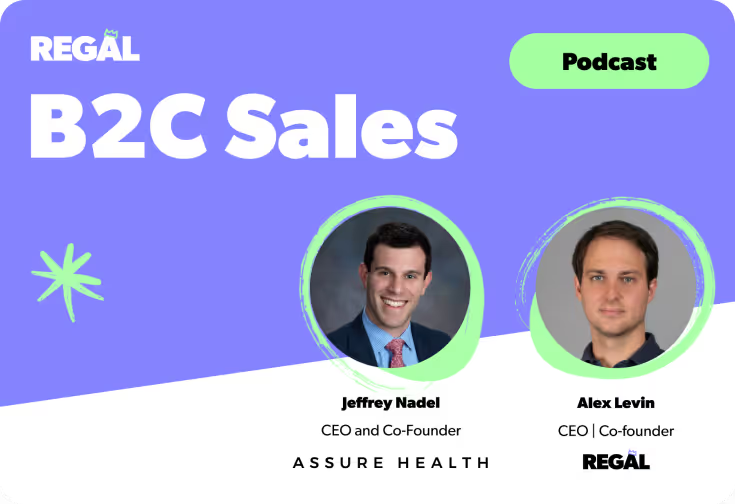
September 2023 Releases
When consumers transitioned from buying everyday products online to everything online, including high consideration consumer services like insurance, healthcare and home services, the eCommerce playbook was no longer sufficient to meet the customer’s buying needs in these categories. The buying dimensions in High Consideration B2C are the exact opposite of retail and the decision frictions in the purchasing process are much greater, so why would one-click checkout work?

My co-founder’s Forbes article Inside The Race to Bring High Consideration Industries Online – And the Importance of B2C Sales articulates how exactly the playbook needs to change for selling these services.
If the playbook for selling these high consideration services is different from retail, then likewise, the underlying growth stack must change. The modern B2C growth stack of Shopify + Klaviyo + Gladly is great for high volume, transactional eCommerce, where discount-focused nudges over email and text are sufficient to remind the buyer to purchase that new fall jacket, and async inbound customer support over email or chat can bridge the minor gaps or flaws in your self-serve digital flows.
For high consideration B2C services, ad hoc discounts don’t cut it: “50% off Life Insurance, Don’t Miss Out on This hot 4th of July Sale. Blast those Fireworks without a Care in the World!!!” And async support through a ticketing system of rotating support agents using templated responses with zero context on your situation also doesn’t cut it for retention: “Hi Jess, I understand you’re unhappy with your Wealth Management account performance. I’m taking over your ticket from my colleague and catching up. I’ve attached an envelope for you to return your terrible first quarter performance and get a full refund.”
Alternatively, if high consideration B2C is more consultative and conversational – perhaps the B2B growth stack of Salesforce + Outreach + Zoom would be a better fit? But that stack is insufficient for different reasons. It’s completely salesperson led, designed for very low transaction volume with 1:1 customer ownership throughout the entire customer lifecycle (meaning it’s still too manual and slow), and the channels of interaction that stack is optimized for are primarily email, LinkedIn and video calls.
Before Regal, most high consideration B2C brands were caught half-way between the B2C growth stack and the B2B growth stack – mixing and matching products from each. Because neither of these are well suited to the use case, the result was a Frankenstein of growth stacks ("Frankenstacks") that were ineffective and hard to manage.
Here’s a recent example from one education company in Regal’s sales pipeline. They have six customer-engagement related tools, three tools with overlapping CRM capabilities, and another three tools that have elements of a CDP (Customer Data Platform).

In the last several years, Regal has led the way in defining the modern growth stack for high consideration B2C commerce. What it aims to support is a buyer’s journey that looks like the following:
This journey can be at the initial acquisition phase when a prospect is buying their first product or service from your brand, or downstream throughout the customer lifecycle – at moments where you have cross-sell, retention or win back opportunities, and the growth stack must be able to identify these moments of potential revenue.
Here are the most effective growth stacks we’ve seen across leading high consideration B2C companies that deliver on that buyer’s journey:
These brands are ~90% self-serve, 10% intervention through proactive conversations. They tend to use Braze as both their CDP and marketing automation platform for email, in-app marketing, SMS offers, and mobile push notifications.
Regal serves as both their “Sales” CRM and CCaaS, used mainly by concierge teams to:

What’s unique about both consumer fintech brands (e.g., neobanks, payment apps) and healthcare companies is that they both experience very high volumes of frequent customer engagement with their mobile apps and other devices – especially after initial acquisition. Their customer interactions are ~70% self-serve and 30% conversations.
They rely on powerful real-time CDPs like Segment for high volume data collection and Braze for in-app and push notifications.
They use Regal to power live conversations in a few ways:

These industries tend to be more sales-heavy because there are more steps and more friction in the acquisition funnel (documents to be signed and exchanged; qualification hurdles; interviews to pass) where 1:1 conversations led by a licensed or admissions rep are necessary. These industries have much less customer engagement post-purchase. They tend to be set-it-and-forget-it or one-off types of transactions, so most of the engagement happens in the lead funnel. How often do you visit your life insurance app?
They are closer to 30% self-serve and 70% conversations, and thus require a more heavy-handed Sales CRM like Salesforce and a marketing automation platform that’s less mobile focused, such as Iterable.
These brands use Regal to:

Looking at these growth stacks (and these are just the successful ones, not all), two obvious questions emerge:
While it may be ideal to have all customer data and engagement centralized into a single, all-knowing, all-purpose system, in reality, that’s really hard and not fully necessary.
There’s no question that more centralized customer data and engagement is better, but when there are now so many modalities of engagement, asking for one solution to do all of them well is currently unrealistic – at most a solution can do 2 (maybe 3) of these well.
As AI replaces more of the workflow previously being done by human agents, it’s possible:
The stack for high consideration B2C commerce is still in its early days, as these businesses have only moved online in earnest in the last 10 years. The advent of real-time data streaming and event-driven systems already reinvented the growth stacks for these industries to support their transition from the offline to online world. And AI no doubt promises another reinvention on the horizon.

Ready to see Regal in action?
Book a personalized demo.







